The Weapon Mounts Market is estimated to be valued at USD 2.2 billion in 2025 and is projected to reach USD 2.8 billion by 2035, registering a compound annual growth rate (CAGR) of 2.5% over the forecast period. A Growth Contribution Index (GCI) analysis shows that the market experiences steady, incremental growth, with a higher contribution from the latter years of the forecast period. Between 2025 and 2030, the market grows from USD 2.2 billion to USD 2.6 billion, contributing USD 0.4 billion in growth, with a CAGR of 3.0%.
This early-stage growth is driven by continued demand for weapon mounts in defense sectors, as well as military modernization and technology upgrades. Weapon mounts are crucial for various land, air, and naval vehicles, providing stability and accuracy for mounted weapons. From 2030 to 2035, the market continues to expand from USD 2.6 billion to USD 2.8 billion, contributing USD 0.2 billion in growth, with a slightly lower CAGR of 1.6%.
This phase sees slower growth as the market approaches maturity, with adoption stabilizing as many military forces already integrate modern weapon mount solutions. The GCI highlights that while growth continues, it becomes more incremental in the later years as the market shifts toward replacement and upgrade cycles rather than initial adoption. The market remains strong, driven by evolving military needs and increasing focus on weapon system performance.
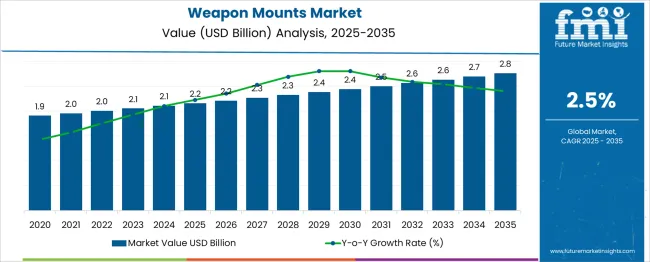
| Metric | Value |
|---|---|
| Weapon Mounts Market Estimated Value in (2025 E) | USD 2.2 billion |
| Weapon Mounts Market Forecast Value in (2035 F) | USD 2.8 billion |
| Forecast CAGR (2025 to 2035) | 2.5% |
The Weapon Mounts market is experiencing significant growth as defense forces worldwide increasingly prioritize precision, stability, and versatility in weapon deployment. The current market scenario reflects heightened demand for advanced mounting solutions driven by rising geopolitical tensions, modernization programs, and increasing adoption of next-generation combat vehicles and systems.
According to defense industry announcements and investor presentations, the market is also supported by technological advancements such as integration with remote-control systems, improved recoil management, and compatibility with diverse weapons. Future growth is anticipated to be fueled by growing investments in defense infrastructure, adoption of unmanned platforms, and emphasis on soldier safety.
Annual reports from defense contractors and government procurement plans further highlight the importance of weapon mounts in enhancing mission effectiveness, extending weapon life, and reducing operational risks. With continuous innovation and focus on lightweight, durable materials, the Weapon Mounts market is expected to sustain its upward trajectory across land, air, and naval domains.
The weapon mounts market is segmented by type, mode of operation, application, and geographic regions. By type, the weapon mounts market is divided into static and non-static. In terms of mode of operation, the weapon mounts market is classified into remotely operated and manually operated.
Based on the application of the weapon mounts market, it is segmented into Land, Sea, and Air. Regionally, the weapon mounts industry is classified into North America, Latin America, Western Europe, Eastern Europe, Balkan & Baltic Countries, Russia & Belarus, Central Asia, East Asia, South Asia & Pacific, and the Middle East & Africa.
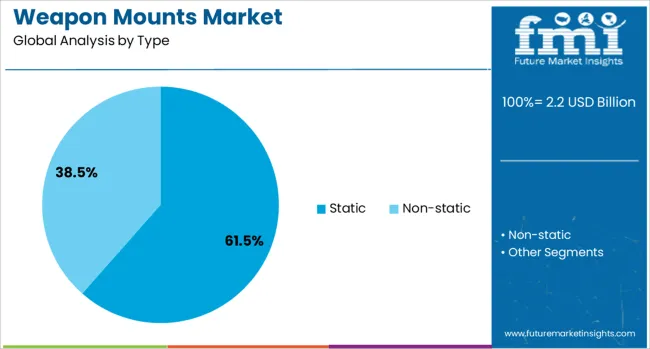
The static type segment is projected to account for 61.5% of the Weapon Mounts market revenue share in 2025, establishing it as the leading type segment. This dominance is being attributed to its robust design, simplicity, and proven effectiveness in fixed and defensive installations, as indicated in defense equipment specifications and procurement documents.
Static mounts have been preferred for their high stability and capacity to handle heavy weapon systems without compromising accuracy or reliability. Press releases from defense agencies have noted that their low maintenance requirements and adaptability to fortified positions make them indispensable in stationary defense scenarios.
Additionally, their integration with modern fire control systems and compatibility with a wide range of calibers have reinforced their appeal in critical infrastructure and base defense. The segment’s prominence has also been maintained by its cost-effectiveness and compliance with stringent durability standards, ensuring consistent performance under diverse operational conditions.
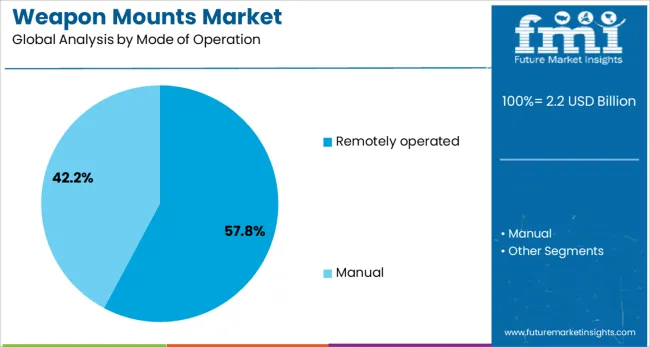
The remotely operated mode of operation segment is anticipated to capture 57.8% of the Weapon Mounts market revenue share in 2025, positioning it as the leading mode of operation. This leadership is being driven by growing emphasis on soldier protection, automation, and precision in combat environments, as noted in defense ministry statements and corporate briefings.
Remotely operated mounts have been increasingly deployed due to their ability to minimize operator exposure to hostile fire while maintaining full control and accuracy of weapon systems. Reports in defense industry journals have highlighted their integration with advanced sensors, targeting systems, and night-vision capabilities, which enhance situational awareness and operational efficiency.
The adoption of these mounts has been encouraged by their compatibility with unmanned platforms and ease of integration into modern vehicles and surveillance systems. These factors have collectively contributed to their dominant position in the market, aligning with contemporary warfare demands and tactical doctrines.
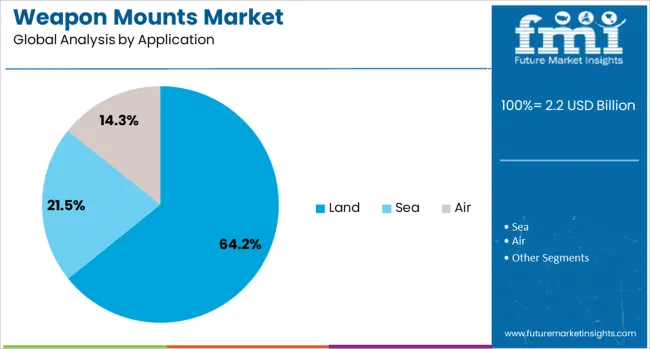
The land application segment is expected to hold 64.2% of the Weapon Mounts market revenue share in 2025, marking it as the largest application segment. This growth is being attributed to the extensive deployment of weapon mounts on armored vehicles, border defense systems, and fixed ground installations, as reflected in defense budget allocations and procurement programs.
Land-based operations continue to account for a significant proportion of military engagements, and mounts play a crucial role in ensuring firepower, stability, and adaptability in diverse terrains. Investor presentations and technology showcases have indicated that advances in modularity and weight optimization have made these mounts even more suitable for fast-moving ground forces.
Their integration with remotely operated and automated systems has further enhanced operational safety and effectiveness in land missions. These characteristics have supported their widespread adoption in both offensive and defensive scenarios, ensuring their continued leadership in the Weapon Mounts market.
The weapon mounts market is growing due to increasing defense and security requirements across the globe. Weapon mounts are critical for stabilizing weapons on vehicles, ships, aircraft, and other platforms, enabling precise targeting and enhancing operational efficiency. The rising demand for military and law enforcement applications, coupled with the need for advanced, durable, and reliable systems, is driving market expansion. Technological advancements in materials and automation are also contributing to the growth of the market, providing enhanced functionality. Despite challenges like high production costs and regulatory requirements, innovations in weapon mount technology offer opportunities for further market growth.
The primary driver of the weapon mounts market is the increasing demand for precision targeting systems and tactical solutions across the defense and security sectors. Weapon mounts are essential for enhancing the performance of firearms, machine guns, and other weapons, providing the stability needed for accurate firing from vehicles, ships, or aircraft. As military and law enforcement agencies focus on improving operational effectiveness, the need for advanced weapon mounts has risen. With the growing emphasis on modernizing military equipment, the integration of stabilized weapon systems into various platforms, such as drones and armored vehicles, is fueling the demand for weapon mounts. Increased global defense spending, particularly in emerging economies, is driving further adoption of advanced weapon mounts for enhanced combat capabilities.
One of the key challenges in the weapon mounts market is the high production cost associated with designing and manufacturing advanced weapon mount systems. These mounts require specialized materials and technology to ensure durability, reliability, and performance under extreme conditions. This often results in higher costs, limiting the affordability of these systems, especially for smaller military forces or law enforcement agencies with constrained budgets. Weapon mounts are subject to stringent regulatory requirements regarding safety, compatibility, and performance. Ensuring compliance with these regulations while maintaining competitive pricing is a significant challenge for manufacturers. These factors may limit the market’s growth, especially in developing countries or regions with lower defense budgets.
The weapon mounts market presents several opportunities driven by ongoing technological advancements and the modernization of military equipment. Innovations in lightweight, high-strength materials such as composites are improving the performance and cost-efficiency of weapon mounts. Additionally, the rise of automation and integration with modern targeting systems is enhancing the functionality of weapon mounts. As defense forces around the world modernize their equipment, the demand for advanced, stable, and precise weapon systems will increase. Emerging markets, particularly in Asia-Pacific and the Middle East, present significant growth opportunities as these regions continue to increase defense spending and modernize their military forces. The development of multi-platform weapon mount systems, adaptable to various vehicles and aircraft, is also driving innovation in this sector.
A key trend in the weapon mounts market is the increasing integration of smart technology into weapon mount systems. These systems are evolving to incorporate features such as real-time targeting data, automated recoil compensation, and integration with advanced aiming and firing systems. The trend towards multi-platform solutions is also growing, where weapon mounts are designed to be adaptable across a variety of platforms, including land, air, and sea-based systems. This provides greater flexibility and efficiency in military operations. The demand for stabilizing mounts for unmanned aerial vehicles (UAVs) and drones is on the rise, driven by the growing use of drones in both defense and commercial applications. These trends are shaping the future of the weapon mounts market, driving innovation and adoption across various sectors.
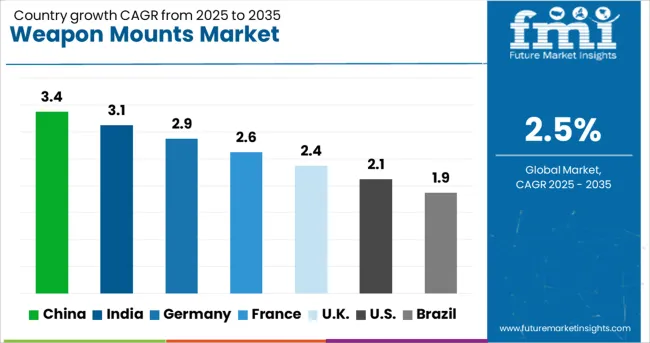
| Country | CAGR |
|---|---|
| China | 3.4% |
| India | 3.1% |
| Germany | 2.9% |
| France | 2.6% |
| UK | 2.4% |
| USA | 2.1% |
| Brazil | 1.9% |
The weapon mounts market is witnessing steady growth globally, with a global CAGR of 2.5%. China leads the market with a growth rate of 3.4%, followed by India at 3.1%. Germany records a growth rate of 2.9%, while France and the UK show growth rates of 2.6% and 2.4%, respectively. The USA trails with a growth rate of 2.1%. This market is primarily driven by the increasing demand for advanced weapon systems, particularly in defense sectors such as land, naval, and air platforms. The analysis includes over 40+ countries, with the leading markets detailed below.
The weapon mounts market in China is projected to expand at a CAGR of 3.4% from 2025 to 2035. As the world's largest military manufacturer, demand for weapon mounts is driven by the increasing modernization of its defense systems. The growing focus on self-reliance in military technology and the rapid development of new armored vehicles, naval ships, and aircraft further contribute to the rising demand for weapon mounts. Additionally, the expansion of China's military infrastructure and strategic investments in high-tech defense systems under initiatives such as the Belt and Road Initiative are expected to support long-term growth in this market.
The weapon mounts market in India is expected to grow at a CAGR of 3.1%. With the Indian government prioritizing defense modernization through its "Make in India" initiative, demand for weapon mounts is surging. The country’s increasing military investments, particularly in armored vehicles, naval vessels, and air defense systems, are key drivers of this market. The Indian defense sector’s emphasis on self-sufficiency and reducing reliance on imports is pushing local manufacturing of advanced defense equipment, further propelling the need for specialized weapon mounts. The growing defense expenditure and the expansion of India's defense technology sector are expected to sustain the market's growth.
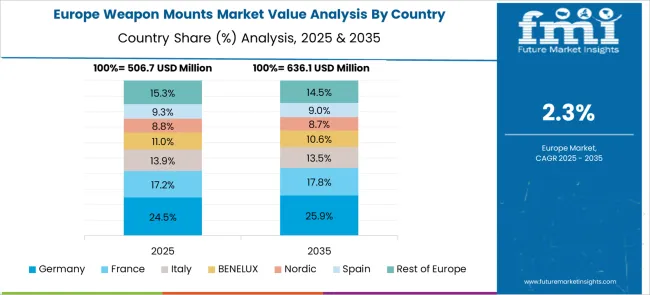
The weapon mounts market in Germany is growing at a CAGR of 2.9% from 2025 to 2035. As a leading defense manufacturing hub within the EU and NATO, Germany is heavily investing in modernizing its defense systems, including armored vehicles, tanks, and naval ships. This modernization drive fuels the need for durable, high-performance weapon mounts. The demand for advanced mounting solutions is also supported by Germany’s strict defense regulations and focus on high-quality engineering. The country’s position as a key player in European and global defense markets, coupled with its strong military alliances, ensures steady demand for weapon mounts in both domestic and international markets.
The UK weapon mounts market is projected to grow at a CAGR of 2.4%f from 2025 to 2035. The UK defense sector is modernizing rapidly, with significant investments in next-generation weapon systems, including land, naval, and air defense platforms. The need for efficient and reliable weapon mounts is growing, especially as the country strengthens its defense partnerships and expands its military infrastructure. With a strong emphasis on operational effectiveness and reliability, the UK is increasingly adopting advanced weapon mount technologies. Furthermore, its focus on cost-effective and versatile solutions for military equipment is creating new opportunities in the weapon mounts market.
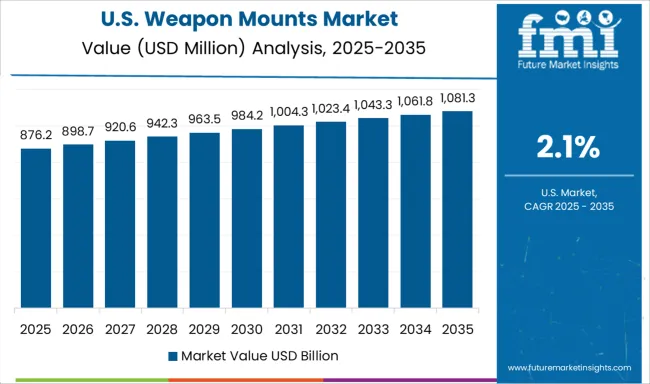
The USA weapon mounts market is expected to grow at a CAGR of 2.1% through 2035. As a global leader in defense technology, the USA continues to invest heavily in modern weapon systems, leading to sustained demand for advanced weapon mounts. The country’s defense modernization programs, focusing on improving performance and operational efficiency, are major drivers of market growth. USA defense contractors are also focusing on developing versatile, high-tech mounting solutions for a wide range of military platforms, including ground vehicles, naval vessels, and aircraft. Additionally, government spending on defense infrastructure, coupled with international defense partnerships, further supports the market's expansion.
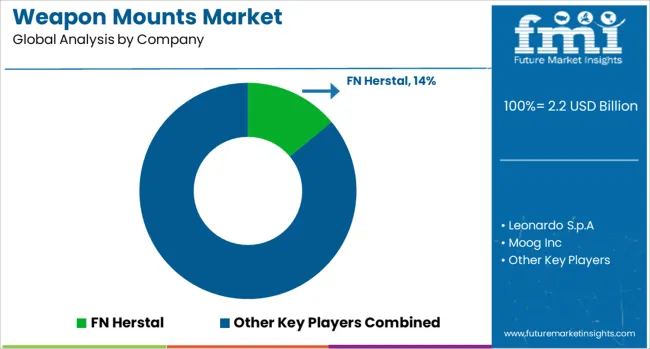
The weapon mounts market is driven by major defense and aerospace companies offering advanced mounting solutions designed to enhance the precision, stability, and performance of weapons in military and defense applications. FN Herstal is a key player, providing high-quality weapon mounts known for their robust design and reliability in demanding combat environments.
Their solutions are widely used in military vehicles, naval platforms, and aircraft. Leonardo S.p.A offers innovative weapon mounting systems that emphasize versatility and integration with modern weaponry, providing enhanced tactical capabilities in both land and naval operations. Moog Inc. is a significant player, providing cutting-edge weapon mounting solutions designed for aerospace and defense applications, with a focus on precision control and durability. Otoker specializes in providing high-performance weapon mounts that cater to a wide range of defense vehicles, focusing on strength, ease of use, and operational efficiency.
Rheinmetall AG is another leading player in the market, offering advanced weapon mount systems designed for military and law enforcement applications, ensuring optimal weapon deployment in critical missions. Rafael Advanced Defense Systems provides robust, high-tech weapon mounting solutions for a variety of defense platforms, including naval vessels and military ground vehicles. Electro Optic Systems and Elbit Systems offer state-of-the-art weapon mounts, integrating advanced electronic systems to provide accurate targeting and efficient weapon deployment.
BAE Systems also contributes to the market with durable and reliable weapon mount systems for various military applications, focusing on innovation and enhancing operational efficiency. Competitive differentiation in the weapon mounts market is driven by factors such as stability, adaptability to different weapon systems, ease of installation, and integration with modern defense platforms. Barriers to entry include high development costs, regulatory compliance, and technological expertise in defense systems. Strategic priorities include improving system integration, enhancing weapon platform compatibility, and expanding product offerings for various defense applications.
| Item | Value |
|---|---|
| Quantitative Units | USD 2.2 Billion |
| Type | Static and Non-static |
| Mode of Operation | Remotely operated and Manual |
| Application | Land, Sea, and Air |
| Regions Covered | North America, Europe, Asia-Pacific, Latin America, Middle East & Africa |
| Country Covered | United States, Canada, Germany, France, United Kingdom, China, Japan, India, Brazil, South Africa |
| Key Companies Profiled | FN Herstal, Leonardo S.p.A, Moog Inc, Otoker, Rheinmetall AG, Rafael Advanced Defense Systems, Electro Optic Systems, Elbit Systems, and BAE Systems |
| Additional Attributes | Dollar sales by product type (stationary weapon mounts, vehicle-mounted weapon systems, aircraft mounts, naval mounts) and end-use segments (military, law enforcement, defense contractors). Demand dynamics are influenced by rising defense budgets, growing military vehicle integration, and the increasing demand for advanced weaponry in both land and naval platforms. Regional trends indicate strong growth in North America and Europe, driven by rising defense spending, while Asia-Pacific is expanding due to increasing military modernization programs. |
The global weapon mounts market is estimated to be valued at USD 2.2 billion in 2025.
The market size for the weapon mounts market is projected to reach USD 2.8 billion by 2035.
The weapon mounts market is expected to grow at a 2.5% CAGR between 2025 and 2035.
The key product types in weapon mounts market are static and non-static.
In terms of mode of operation, remotely operated segment to command 57.8% share in the weapon mounts market in 2025.






Our Research Products

The "Full Research Suite" delivers actionable market intel, deep dives on markets or technologies, so clients act faster, cut risk, and unlock growth.

The Leaderboard benchmarks and ranks top vendors, classifying them as Established Leaders, Leading Challengers, or Disruptors & Challengers.

Locates where complements amplify value and substitutes erode it, forecasting net impact by horizon

We deliver granular, decision-grade intel: market sizing, 5-year forecasts, pricing, adoption, usage, revenue, and operational KPIs—plus competitor tracking, regulation, and value chains—across 60 countries broadly.

Spot the shifts before they hit your P&L. We track inflection points, adoption curves, pricing moves, and ecosystem plays to show where demand is heading, why it is changing, and what to do next across high-growth markets and disruptive tech

Real-time reads of user behavior. We track shifting priorities, perceptions of today’s and next-gen services, and provider experience, then pace how fast tech moves from trial to adoption, blending buyer, consumer, and channel inputs with social signals (#WhySwitch, #UX).

Partner with our analyst team to build a custom report designed around your business priorities. From analysing market trends to assessing competitors or crafting bespoke datasets, we tailor insights to your needs.
Supplier Intelligence
Discovery & Profiling
Capacity & Footprint
Performance & Risk
Compliance & Governance
Commercial Readiness
Who Supplies Whom
Scorecards & Shortlists
Playbooks & Docs
Category Intelligence
Definition & Scope
Demand & Use Cases
Cost Drivers
Market Structure
Supply Chain Map
Trade & Policy
Operating Norms
Deliverables
Buyer Intelligence
Account Basics
Spend & Scope
Procurement Model
Vendor Requirements
Terms & Policies
Entry Strategy
Pain Points & Triggers
Outputs
Pricing Analysis
Benchmarks
Trends
Should-Cost
Indexation
Landed Cost
Commercial Terms
Deliverables
Brand Analysis
Positioning & Value Prop
Share & Presence
Customer Evidence
Go-to-Market
Digital & Reputation
Compliance & Trust
KPIs & Gaps
Outputs
Full Research Suite comprises of:
Market outlook & trends analysis
Interviews & case studies
Strategic recommendations
Vendor profiles & capabilities analysis
5-year forecasts
8 regions and 60+ country-level data splits
Market segment data splits
12 months of continuous data updates
DELIVERED AS:
PDF EXCEL ONLINE
Smart Weapons Market Size and Share Forecast Outlook 2025 to 2035
Aircraft Weapons Market Size and Share Forecast Outlook 2025 to 2035
Aircraft Mounts Market Size and Share Forecast Outlook 2025 to 2035
Automatic Weapons Market Size and Share Forecast Outlook 2025 to 2035
Automated Weapon System Market Analysis - Size, Share, and Forecast Outlook 2025 to 2035
Concealed Weapon Detection Systems Market Trends – Growth & Forecast 2025-2035
Anti Drone Weapons Market Size and Share Forecast Outlook 2025 to 2035
Hypersonic Weapons Market Size and Share Forecast Outlook 2025 to 2035
Anti-Vibration Mounts Market
Shoulder Fired Weapon Market
Electromagnetic Weapons Market Size and Share Forecast Outlook 2025 to 2035
Directed Energy Weapons Market Size and Share Forecast Outlook 2025 to 2035
Air-based Remote Weapon Stations Market Size and Share Forecast Outlook 2025 to 2035
Naval Based Remote Weapons Station Market Size and Share Forecast Outlook 2025 to 2035
Solar Panel Tracking Mounts Market

Thank you!
You will receive an email from our Business Development Manager. Please be sure to check your SPAM/JUNK folder too.
Chat With
MaRIA